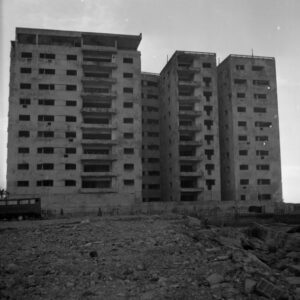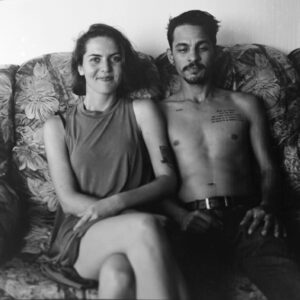Francesca Svampa, independent producer, filmmaker and Italian visual artist living in Barcelona, Spain, exhibits “A Movie in a pic”, a collection of negatives that generate micro films, from 5 to 28 April 2024 at Il Meccanico gallery in Verona. The project, exhibited together with “Gli Stressonauti” series by Giovanni Sellari in the double show entitled “Analogue – Artificial” presents itself as an alternative way of understanding analogic photography. The images originate in a negative, part of it or a manipulation of some kind. A collection of very short films. A project that was born as a game to be able to make films and work with analogic photography with the minimum of resources.

Francesca Svampa, “Ceci n’est pas un message (Questo non è un messaggio)”, Italia, Cuba, 120 mm, 59 sec., 2018, courtesy Il Meccanico
Simone Azzoni: Can you describe your project and its genesis? How did you work?
Francesca Svampa: A movie in a pic is a project that consists of a collection of negatives, the image of which generates a film of maximum 60 seconds. I remember that I moved to Barcelona, after having attended the Maestria en Cine Ensayo at the EITV school in Cuba. I really wanted to make films and experiment with analogic photography, but the working conditions and costs of a European city made it impossible for me. Very frustrating. So I had this idea to be able to satisfy my creative needs with little time and few economic resources. The project allows, on a small scale, the entire production process. I start from the shot in an intuitive way, everything applies: from encounters on the street to everyday life. Since the film is just an image, I don’t need to premeditate too much, even if I sometimes I take a particular photo that I had in mind. Then there is the moment of development and digital editing of the film. From a creative point of view, one of the most interesting aspects for me is being able to create a condensed film idea. As in a seed, everything is already there potentially, but it is very small.
What does dialogue with analogic photography mean to you? What messages does the material you work with communicate? What do you take away from the film?
The use of the word “dialogue” is interesting because it can actually be understood as a real dialogue. What captures me about the analogic image is its fragility as an object and process on the one hand, and its mystery on the other. When I take an analogic photo, only with development the image “reveals itself”. From this vision an answer comes and so on. The development process is a moment of relationship with the image even before seeing it. It has its times, it requires participation, but it is also a relaxed, domestic moment of creative waiting, in which you have to use your hands. Somehow I think my state of mind during development somehow transfers to the images, I think it’s a magical moment. In the photo there is always the present moment, of the shot and of the development. In that image there is that water, that trembling, that scratch, which are the result of a set of micro events specific and unique to the present moment. It is combined with the organic nature of the film, which like the body decays over time, makes it alive and unique. .

Francesca Svampa, “Ensayo para una historia de amor (Saggio su una storia d’amore)”, Italia, Cuba, 120 mm, 59 sec., 2020, courtesy Il Meccanico
Does the message influence and give substance to the image? How?
The film is always “called” by the image as regards the visual construction. There is an starting phase of questioning the image, both on a formal and content level. Then there is the encounter with error which is often a harbinger of new paths. In the film there is a questioning and the message is open. I don’t look for a closed answer and the result is a more powerful image, because openness leaves room for questioning, imagining, research. It stimulates the imagination. By focusing on a formal structure, the themes emerge spontaneously and are those already present in my gaze. A bit like thinking in images, which is natural for me. So there is the theme of living, of public space, as well as women, cinema and relationships, both micro and macro. Thinking about the “Analogue-Artificial” exhibition that involves me at Il Meccanico, I am very intrigued by the fact that the viewers see the photo, then the film and when they see the photo again their gaze has changed. How? Maybe they can imagine their own films with the same image, because they have a different relationship with it. Well, in this sense I would really like them to tell me what their experience is like..
In your opinion, what is the boundary between experimental cinema and video art?
I think the line between the two is blurred. Generally, the place and form of projection leads one to lean towards one area or the other. As for me, I always think about making a film. Unless it’s something that doesn’t “articulate” over time, then I would think about video art. One example is a series of self-portrait videos that I call “self-portrait with light”. This boundary arises when choosing how and where to present a work. In the case of “A movie in a pic”, for example, some videos were presented in film festivals, not even experimental, but without the photo and the negative. In “Analogue – Artificial”, however, the exhibition format will present the complete form of the project, with photo and negative. But at the same time this is a polymorphic project, there is no correct form, the variations are emanations of the same idea.

Francesca Svampa, “My calle 13”, Italia, Cuba, 120 mm, 59 sec., 2018, courtesy Il Meccanico
Image and moving image: how did you build this relationship of meaning?
Time is the crucial variable, in the photo it is potentially infinite, while in the moving image time is dictated by the film and its duration is part of the meaning. Then the fragmentation, modification and movement of and in the image also enters. For each image it is very intuitive and I believe it depends on having given this game a few simple rules. The first is: each short film is created with a single image, that of a 120 mm negative developed by hand. The second is: each short film lasts maximum one minute. There is also an unwritten rule: in every film, at least for a moment, you must see the image in its entirety. For the rest there are no constraints, restrictions or expectations. Each film can have a different treatment, theme and language. The image can be modified, manipulated, destroyed. The constraint, the restriction is an aid to creation. The small format and having only one image lead me to do an extreme synthesis, to focus and develop a central idea, both formal and thematic.
There is a return to a certain craftsmanship in photography (think for example of cyanotype) how do you explain it?
Intuitively I would say that it is due to the confluence of two elements: the increase in access to the knowledge of these techniques given by the web and the pleasure of using the hands in a context that requires the relationship with a screen in most daily activities. Personally, I am attracted by the imperfection of craftsmanship. Precisely because with digital and technology it is possible to create perfect images and in the commercial world there is a chase for the latest technological model, the “accident”, which occurs during a hand process, becomes interesting and unique, as the imperfection does. Obviously it doesn’t mean doing things badly, but it changes the attitude towards the process and the result. It requires an opening which in turn breaks and can show interesting ways forward.
Info:
Francesca Svampa and Giovanni Sellari, Analogue – Artificial
05/04/2024 – 30/04/2024
Il Meccanico
Via San Vitale 2b Verona
www.ilmeccanico.org

He is an art critic and professor of Contemporary Art History at IUSVE. He also teaches Critical Image Reading at the Palladio Institute of Design in Verona and Contemporary Art at the Master of Publishing at the University of Verona. He has curated several contemporary art exhibitions in unconventional places. He is the artistic director of the Grenze Photography Festival. He is a theater critic for national magazines and newspapers. He organizes research and experimentation theatrical events. Among the recent publications Frame – Videoarte e dintorni for the University Library, Lo Sguardo della Gallina for Lazy Dog Editions and for Mimemsis Smagliature in 2018 and 2021 for the same publishing house, Theater and photography.






NO COMMENT